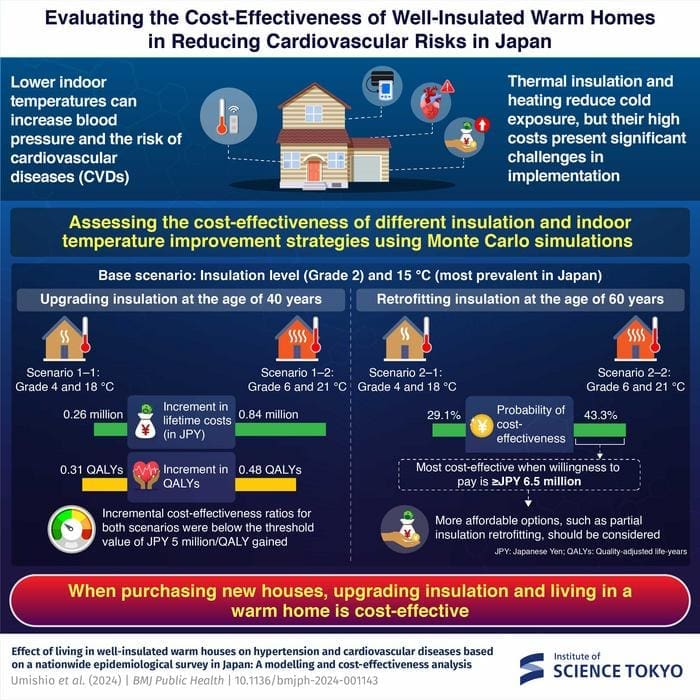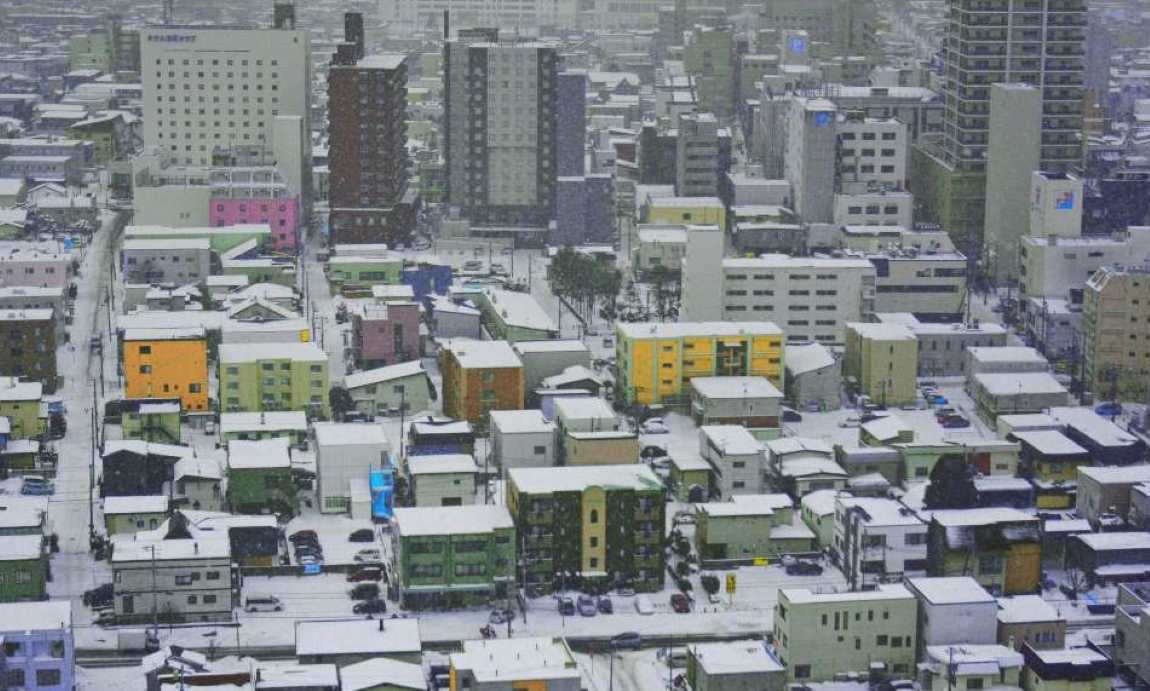Scientists report that upgrading the insulation in new homes is a cost-effective method for reducing the risk of cardiovascular diseases.
During winter, cold indoor temperatures can increase blood pressure, leading to hypertension and an increased risk of cardiovascular diseases (CVDs). While insulation and heating can keep homes warm, they may be expensive to install and maintain. However, these costs may be offset by health benefits, such as lower medical bills and longer, healthier lives from insulating homes.
Identifying the most cost-effective insulation strategy can help keep homes warm, prevent diseases, and save lives.

In this vein, a research team led by Assistant Professor Wataru Umishio from Institute of Science Tokyo (Science Tokyo) investigated the cost-effectiveness of living in well-insulated warm homes to prevent CVDs by comparing houses in Japan with different levels of thermal insulation and indoor temperature.
The multidisciplinary team included researchers from Science Tokyo, Institute for Built Environment and Carbon Neutral for SDGs, Jichi Medical University School of Medicine, University of Occupational and Environmental Health, Tokyo Dental College Ichikawa General Hospital, The University of Kitakyushu, and Nara Medical University School of Medicine.
Their study was published in BMJ Public Health on September 24, 2024.
Explaining the motivation behind their study, Umishio says: “In Japan, a rapidly aging country, over 90% of homes had indoor temperatures below 18°C, which is the level recommended by the World Health Organization. Since older adults are more vulnerable to low temperatures and at a higher risk for CVDs, there is an urgent need to address housing and health issues here.”
The researchers collected data from a nationwide health survey supported by the Ministry of Land, Infrastructure, Transport and Tourism of Japan and developed an economic model to explore the relationship between indoor temperature, blood pressure, and CVDs.
Using this model, they created five home scenarios. The base scenario represented a typical home in Japan with lower insulation and an indoor temperature of 15°C. Two scenarios (1-1 and 1-2) focused on upgrading insulation when purchasing new homes at the age of 40 years, with insulation grades ranging from moderate (Grade 4, 18°C) to high (Grade 6, 21°C). The other two scenarios (2-1 and 2-2) examined retrofitting older homes with similar insulation improvements at the age of 60 years.
They then ran simulations with 100,000 virtual husband-and-wife pairs to analyze lifetime costs for insulation, heating, and medical treatments for hypertension and CVDs, and measured healthy life expectancy using quality-adjusted life years (QALYs).
For the scenarios of upgrading insulation, lifetime costs increased by JPY 0.26 million for Scenario 1-1 and JPY 0.84 million for Scenario 1-2 compared with the base scenario. This means that 74.1% and 57.9% of the insulation costs were recovered, primarily due to reduced medical expenses for CVDs.
Moreover, healthy life expectancy for couples increased by 0.31 QALYs in Scenario 1-1 and 0.48 QALYs in Scenario 1-2. As a result, the incremental cost-effectiveness ratio (ICER) for both scenarios was lower than Japan’s threshold of JPY 5 million per QALY, indicating that the health benefits gained justify the upgrading costs.
On the other hand, retrofitting insulation may not be as favorable. The probabilistic sensitivity analyses showed that Scenario 2-2 was cost-effective only for those willing to pay JPY 6.5 million or more. However, this amount exceeds Japan’s ICER threshold, making it less reasonable. Therefore, more affordable options, such as partial insulation retrofitting, should be considered.
In this evaluation, the researchers focused solely on hypertension and CVDs. However, well-insulated and warm houses are known to help prevent respiratory diseases and nocturia. By including other health conditions in the scope of evaluation, retrofitting insulation may become a more reasonable option.
Umishio emphasizes: “These findings will help policymakers make informed decisions about health and housing improvements, and encourage the use of well-insulated houses, contributing to the Sustainable Development Goals 3, 10, 11, and 13, which focus on health, reduced inequalities, sustainable cities, and climate action.”
To conclude, this study can pave the way for a future where healthy housing is prioritized to prevent winter-related health risks.
***
Institute of Science Tokyo (Science Tokyo) has been established on October 1, 2024, following the merger between Tokyo Medical and Dental University (TMDU) and Tokyo Institute of Technology (Tokyo Tech), with the mission of “Advancing science and human wellbeing to create value for and with society.”
Journal Reference:
Wataru Umishio, Toshiharu Ikaga, Kazuomi Kario, Yoshihisa Fujino, Naoki Kagi, Masaru Suzuki, Shintaro Ando, Keigo Saeki, Shuzo Murakami, ‘Effect of living in well-insulated warm houses on hypertension and cardiovascular diseases based on a nationwide epidemiological survey in Japan: a modelling and cost-effectiveness analysis’, BMJ Public Health 2 (2): e001143 (2024). DOI: 10.1136/bmjph-2024-001143
Article Source:
Press Release/Material by Institute of Science Tokyo
Featured image credit: Adrian Siaril | Unsplash



